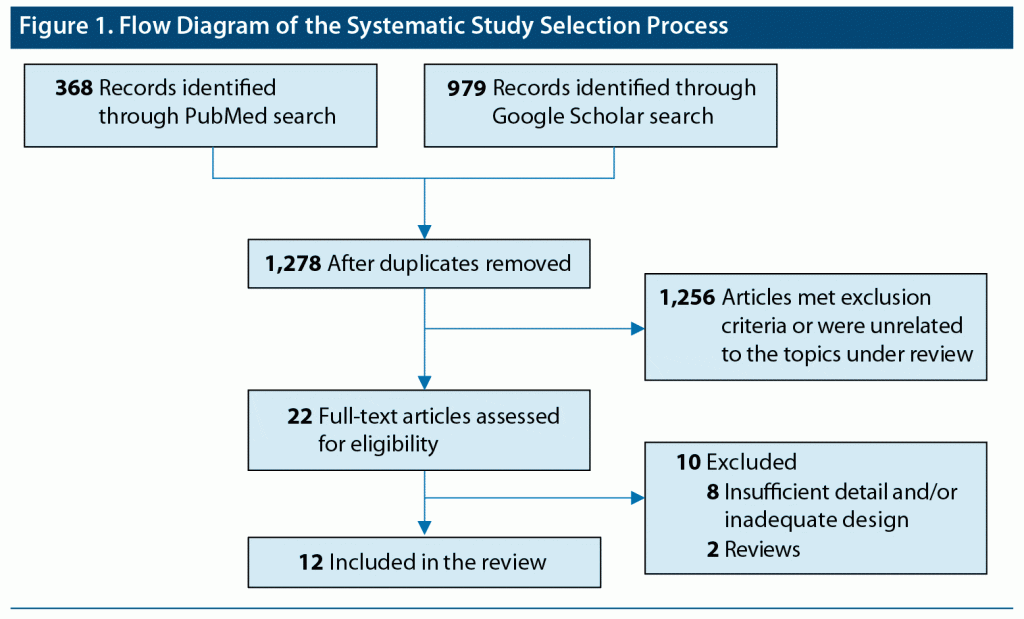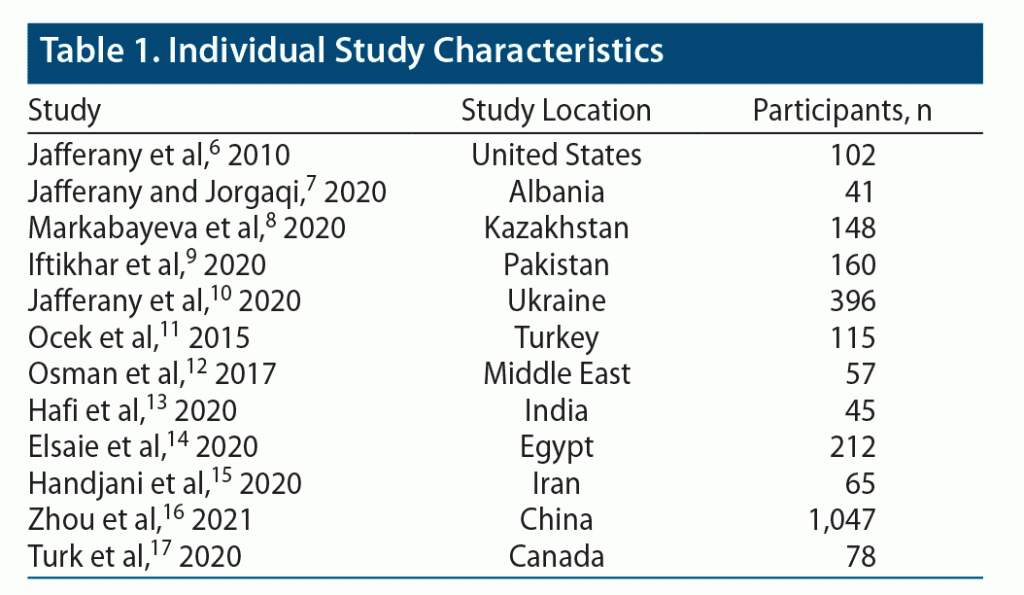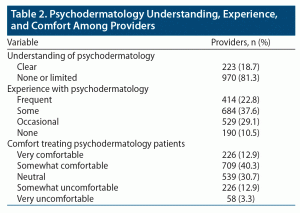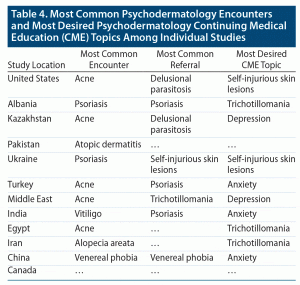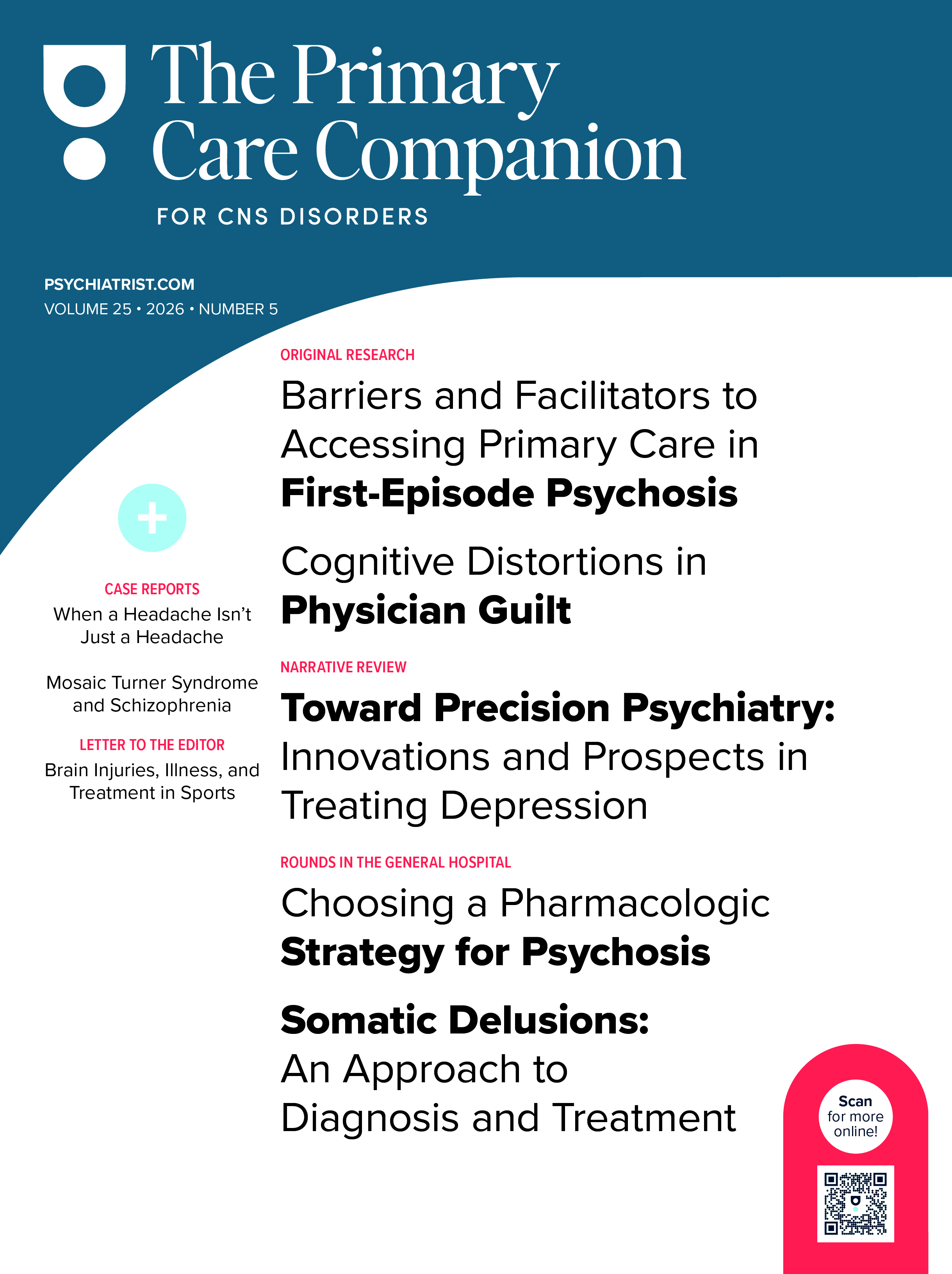ABSTRACT
Objective: To report findings generated from an analysis of available literature on psychodermatology knowledge, awareness, and practice patterns among dermatologists worldwide to better elucidate their educational needs and referral practices.
Data Sources: To identify literature from inception to December 23, 2020, the following search strategy was used within PubMed and Google Scholar databases: psychodermatology OR psychocutaneous disorders OR psychodermatology practice patterns OR psychodermatology awareness OR psychodermatology attitudes OR psychodermatology knowledge. Non-English studies were excluded. Studies were included if they were identified as having collected data from a survey instrument assessing psychodermatology awareness, knowledge, and practice patterns of dermatologists and dermatology trainees.
Study Selection and Data Extraction: Of 1,347 records screened, a total of 12 cross-sectional studies were identified as having collected data from 2,466 dermatologists in 18 countries worldwide. Individual study and overall response frequencies were extracted for each variable of interest by an independent reviewer.
Results: Although most respondents provided weekly psychodermatologic care, only 13% reported feeling very comfortable treating patients with psychocutaneous concerns. Only 19% of respondents had a clear understanding of psychodermatology, and almost two-thirds of participants had no formal training in psychodermatology. Seventy-three percent of dermatologists reported interest in continuing medical education.
Conclusions: A considerable number of patients present to their physician with a psychocutaneous concern. As such, dermatologists, psychiatrists, and primary care providers may benefit from an understanding of the presentations and management of the most common psychodermatology complaints. Incorporation of psychodermatology curriculums into training programs and educational activities should be considered.
Prim Care Companion CNS Disord 2022;24(4):21r03175
To cite: Christensen RE, Jafferany M. Global awareness, knowledge, and practice patterns of psychocutaneous medicine: a primary care perspective. Prim Care Companion CNS Disord. 2022;24(4):21r03175.
To share: https://doi.org/10.4088/PCC.21r03175
© 2022 Physicians Postgraduate Press, Inc.
aRutgers Robert Wood Johnson Medical School, New Brunswick, New Jersey
bDepartment of Psychiatry and Behavioral Sciences, Central Michigan University College of Medicine, Mount Pleasant, Michigan
*Corresponding author: Rachel E. Christensen, BS, Rutgers Robert Wood Johnson Medical School, 125 Paterson St, New Brunswick, NJ 08901 ([email protected]).
Psychodermatology is a medical specialty centered on the interplay between cutaneous and psychiatric symptomatology. Psychocutaneous disease may include the exacerbation of a dermatologic condition from underlying stress or anxiety, psychological distress secondary to a dermatologic condition, or skin lesions that are self-induced in the context of a psychiatric disorder (ie, nonsuicidal self-injury). More than 30% of dermatology patients are estimated as presenting with a psychiatric comorbidity complicating their dermatologic condition.1–4 Moreover, there is a greater prevalence of psychiatric conditions among dermatology inpatients compared to other medical inpatients and among dermatology outpatients compared to the general population.5
Despite the prevalence of psychocutaneous disease among patients, the topic of psychodermatology is underrepresented in dermatologic research and training. As such, many patients suffering from psychocutaneous diseases may seek help from other specialists including psychiatrists and primary care providers. Currently, however, little is known about the dermatologist experience with psychodermatology, including the frequency of patient encounters, the comfort in treating psychocutaneous diseases, and the rate of referral to psychiatrists or other primary care providers. A better understanding of the training gaps and practice patterns among dermatologists with regard to psychocutaneous diseases can help other specialists understand and prepare for their role as caregivers to this unique patient population. Moreover, this information may facilitate the development of targeted and effective additions to residency curriculums and continuing medical education (CME) activities so that psychocutaneous disease identification and management is improved in the most relevant specialties. The current study sought to report key findings generated from an analysis of available literature on psychodermatology knowledge, awareness, and practice patterns among dermatologists worldwide to better elucidate the education needs and referral practices of providers.
METHODS
To identify literature from inception to December 23, 2020, the following search strategy was used within the PubMed and Google Scholar databases: psychodermatology OR psychocutaneous disorders OR psychodermatology practice patterns OR psychodermatology awareness OR psychodermatology attitudes OR psychodermatology knowledge. Studies were included if they were identified as having collected data from a survey instrument developed by Jafferany and colleagues6 assessing psychodermatology awareness, knowledge, experience, and training needs of dermatologists and dermatology trainees. Studies were excluded if they were reviews or book chapters, in a non-English language, or had insufficient detail. Of the 1,347 records screened, 12 cross-sectional studies6–17 meeting eligibility were identified. A flow diagram of the study selection process is shown in Figure 1. For each included study, data were extracted for each variable of interest by an independent reviewer. Individual study data were pooled, when possible, to calculate overall frequencies for each variable.
Collectively, the 12 studies provided data from 2,466 dermatologists in 18 countries throughout North America, Europe, and Asia.6–17 Included studies, study locations, and number of study participants are provided in Table 1. In all studies, survey responses were collected by sending surveys to dermatologists registered on mailing lists or administering surveys to attendees during regional conferences. Survey response rates ranged between 37% and 86%. Overall, 78% of respondents identified as dermatologists and 22% identified as trainees. Sixty-six percent of respondents were female, and 90% practiced in urban settings. Thirteen percent of respondents were aged < 30 years, 34% were between 31 and 40 years, 31% were between 41 and 50 years, and 22% were ≥ 51 years. Twenty-five percent of respondents had practiced < 5 years, and 59% had practiced > 10 years. Eighteen percent of respondents worked in private practice, 45% worked in a hospital-based setting, and 19% worked in a university-based setting.
RESULTS
Survey questions assessed psychodermatology understanding, experience, and comfort among providers (Table 2). Overall, 19% of respondents had a clear understanding of psychodermatology, with the highest percentage in Canada (45%) and the lowest percentage in Kazakhstan (0%). Only 13% of total respondents reported feeling very comfortable treating patients presenting with psychocutaneous concerns, with the highest percentage in the United States (42%) and the lowest percentage in Egypt (4%).
Respondents were also asked to report on the quantity of patients presenting with psychiatric concerns and the frequency with which they refer psychodermatology patients to psychiatrists (Table 3). The studies with the highest percentage of respondents that reported seeing over 30 psychodermatology cases per week were from Iran (86%), India (80%), and the Middle East (76%). The studies with the greatest percentage of respondents reporting weekly or monthly referrals to psychiatrists were from Iran (62%) and India (53%).
Moreover, respondents were questioned about their prior training in psychodermatology as well as their interest in future educational opportunities. Overall, 65% of participants had no formal training in psychodermatology, with the least training reported in Albania (20%) and China (22%) and the most training in the United States (58%) and India (58%). Approximately 85% of respondents were unaware of psychodermatology resources, with Albania reporting the least awareness (0%) and Egypt reporting the most (25%). Among the 73% of overall participants that expressed interest in future psychodermatology CME opportunities, India (87%), China (85%), and the Middle East (78%) had the most interested respondents. The most common psychodermatology office encounters, most frequent referral to psychiatrists, and most desired CME psychodermatology topic for each study are outlined in Table 4.
DISCUSSION
In this review, we examined literature centered on psychodermatology awareness, knowledge, and practice patterns of dermatologists and dermatology trainees from 18 countries across North America, Europe, and Asia. More than half of participants reported seeing > 30 psychodermatology cases per week, with the most common office encounters being acne, psoriasis, alopecia areata, atopic dermatitis, vitiligo, and venereal phobia. Although most respondents provided weekly psychodermatologic care, only 13% reported feeling very comfortable treating patients presenting with psychocutaneous concerns. Only 19% of respondents had a clear understanding of psychodermatology. Approximately one-quarter of participants reported referring patients with psychocutaneous diseases to psychiatrists at least monthly. Almost two-thirds of participants had no formal training in psychodermatology, and 85% of respondents were unaware of psychodermatology resources. Approximately 73% reported interest in continued education with emphasis on training in secondary depression and anxiety, trichotillomania, and self-injurious skin lesions.
The findings of this review have several important implications. First, our results confirm that there exists a considerable number of patients presenting to their physician with a psychocutaneous concern. As such, dermatologists, psychiatrists, and primary care providers all may benefit from an understanding of the presentations and management of the most common psychodermatology complaints. Second, our analysis suggests that dermatologists may lack the training and comfort necessary to provide quality care to patients presenting with pyschocutaneous concerns, highlighting the important role psychiatrists and primary care physicians may play in helping to manage such patients. Finally, our findings showed a lack of training as well as a substantial interest in further education, which suggests that inclusion of psychodermatology topics into medical education is a worthwhile effort.
Currently, there are no dermatology, psychiatry, or primary care residency programs that have accredited training in psychodermatology, and only limited opportunities exist for formal education. One of these opportunities, the Diploma in Psychodermatology, has been recently introduced by The European Society for Dermatology and Psychiatry and is aimed at better informing dermatologists, psychiatrists, and psychologists. Moreover, the development of an accredited 1-year psychodermatology fellowship open to graduates of dermatology and psychiatry residencies has been proposed, and while such a fellowship would likely have a powerful impact on the training of physicians and the care of patients, its development would require overcoming substantial logistical challenges.18 Residency programs and CME developers should consider incorporating more comprehensive education and training on identification and management of the most commonly encountered psychodermatology diseases.
Moreover, our finding that a high percentage of dermatologists experience discomfort treating psychocutaneous disease highlights the potential utility of guideline development related to psychodermatology management. These guidelines could contain information related to basic treatment strategies for the most encountered psychiatric comorbidities, as well as referral practices, including clinical scenarios in which a dermatologist should treat a psychiatric condition themselves versus refer to a psychiatrist or primary care provider. Such guidelines would be especially useful for dermatologists working with patients who are resistant to a psychiatric diagnosis or unwilling to follow through with psychiatric referral and for primary care providers who may encounter psychodermatology cases with which they are unfamiliar.
Finally, our findings demonstrating a high frequency of psychiatric referrals during dermatology office encounters support the concept of specialized, combined-care clinics in which dermatologists, psychiatrists, and primary care providers participate in patient consultations and treatment-related decision-making. A systematic literature review19 examining data from combined psychiatry and dermatology clinics worldwide suggests that this approach not only improves patient outcomes but also provides valuable medical education to participating providers.
The current study has several limitations. First, variability in the research design, reported data, and sample sizes of the included studies limit the ability to conduct pooled-data analysis and draw concrete conclusions. Second, data collected in the United States, Turkey, India, and Albania reflect only a specific region of each country and cannot be considered country representative. Third, while our findings provide a unique global perspective on psychodermatology practice patterns, application of the pooled results should be performed with caution due to international variation in practice patterns, residency training programs, and available medical education resources. Fourth, dermatologists with particular interest in psychodermatology may have been more inclined to complete the self-report survey, potentially introducing sampling bias in individual studies that overestimates psychodermatology knowledge and awareness.
In conclusion, the results of the current review highlight the high rates of psychodermatology encounters and referrals that occur in dermatology offices and underscore the need for increased psychodermatology training worldwide. Dermatologists, psychiatrists, and primary care providers can each play an important role in the management of this unique patient population and may benefit from an increased understanding of the presentation and management of the most common psychocutaneous disorders.
Submitted: October 16, 2021; accepted January 17, 2022.
Published online: July 26, 2022.
Relevant financial relationships: None.
Funding/support: None.
Previous presentation: Project presented at the 19th Congress—European Society for Dermatology and Psychiatry (ESDaP) & 2nd Brain Skin Colloquium Conference; virtual; June 11–12, 2021.
Clinical Points
- Psychodermatology, an interface of dermatology and psychiatry, is a newer subspecialty gaining momentum worldwide.
- There exists a considerable need and interest for increased psychodermatology training and awareness globally.
- Psychiatry/dermatology/primary care liaison clinics and a holistic approach may prove helpful in the treatment of patients with psychocutaneous disorders.
References (19)

- Picardi A, Abeni D, Melchi CF, et al. Psychiatric morbidity in dermatological outpatients: an issue to be recognized. Br J Dermatol. 2000;143(5):983–991. PubMed CrossRef
- Wessely SC, Lewis GH. The classification of psychiatric morbidity in attenders at a dermatology clinic. Br J Psychiatry. 1989;155(5):686–691. PubMed CrossRef
- Attah Johnson FY, Mostaghimi H. Comorbidity between dermatologic diseases and psychiatric disorders in Papua New Guinea. Int J Dermatol. 1995;34(4):244–248. PubMed CrossRef
- Aktan S, Özmen E, Şanli B. Psychiatric disorders in patients attending a dermatology outpatient clinic. Dermatology. 1998;197(3):230–234. PubMed CrossRef
- Hughes JE, Barraclough BM, Hamblin LG, et al. Psychiatric symptoms in dermatology patients. Br J Psychiatry. 1983;143(1):51–54. PubMed CrossRef
- Jafferany M, Vander Stoep A, Dumitrescu A, et al. The knowledge, awareness, and practice patterns of dermatologists toward psychocutaneous disorders: results of a survey study. Int J Dermatol. 2010;49(7):784–789. PubMed CrossRef
- Jafferany M, Jorgaqi E. Psychodermatology in Balkans: knowledge, awareness, and practice patterns of dermatologists in Albania. Dermatol Ther (Heidelb). 2020;33(3):e13286. PubMed CrossRef
- Markabayeva A, Ospanova S, Jafferany M. Psychodermatology: knowledge, awareness, and attitude of dermatologists in Kazakhstan. Int J Dermatol. 2020;59(4):e105–e109. PubMed CrossRef
- Iftikhar U, Jafferany M, Khawaja AR. Awareness and knowledge toward psychodermatology in South Asia: a Pakistani perspective. Int J Dermatol. 2020;59(6):e219–e221. PubMed CrossRef
- Jafferany M, Havryliuk O, Adaskevich U, et al. Psychodermatology in Ukraine and Belarus: an Eastern European perspective. Int J Dermatol. 2020;59(5):e151–e153. PubMed CrossRef
- Ocek T, Kani AS, Baş A, et al. Psychodermatology: knowledge, awareness, practicing patterns, and attitudes of dermatologists in Turkey. Prim Care Companion CNS Disord. 2015;17(2). PubMed CrossRef
- Osman OT, Souid AK, Al-Mugaddam F, et al. Attentiveness of dermatologists in the Middle East to psychocutaneous medicine. Prim Care Companion CNS Disord. 2017;19(2). PubMed CrossRef
- Hafi B, Abdul Latheef EN, Uvais NA, et al. Awareness of psychodermatology in Indian dermatologists: a South Indian perspective. Dermatol Ther (Heidelb). 2020;33(6):e14024. PubMed CrossRef
- Elsaie ML, Hanafy NS, Zaky MS, et al. Psychodermatology knowledge and awareness: a cross-sectional Egyptian perspective. Dermatol Ther (Heidelb). 2020;33(6):e14239. PubMed CrossRef
- Handjani F, Saki N, Emad N, et al. Psychodermatology in Iran: a survey on knowledge, awareness, and practice patterns in Iranian dermatologists. Dermatol Ther (Heidelb). 2020;33(6):e14009. PubMed CrossRef
- Zhou T, Zhang Y, Zhang Y, et al. Psychodermatology knowledge and awareness in Chinese dermatologists: results of a survey study. Dermatol Ther (Heidelb). 2021;34(1):e14668. CrossRef
- Turk T, Fujiwara E, Abba-Aji A, et al. Psychodermatology in Canada: a national survey assessment of dermatologists’ perception, practice patterns, and challenges. J Cutan Med Surg. 2020;25(3):249–256. PubMed
- Ryan MP, Wagner RF. Psychodermatology fellowship: is it time? Dermatol Online J. 2021;27(2):13030/qt7j15s8kh. PubMed
- Patel A, Jafferany M. Multidisciplinary and holistic models of care for patients with dermatologic disease and psychosocial comorbidity: a systematic review. JAMA Dermatol. 2020;156(6):686–694. PubMed CrossRef
Please sign in or purchase this PDF for $40.
